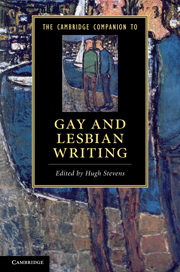Book contents
- Frontmatter
- Homosexuality and literature: an introduction
- Part I Repression and Legitimation
- Part II Affiliations
- Part III Literary Traditions
- 10 Encountering the past in recent lesbian and gay fiction
- 11 Queer cross-gender collaboration
- 12 Naming the unnameable: lesbian and gay love poetry
- 13 The queer writer in New York
- Guide to further reading
- Index
11 - Queer cross-gender collaboration
from Part III - Literary Traditions
Published online by Cambridge University Press: 28 January 2011
- Frontmatter
- Homosexuality and literature: an introduction
- Part I Repression and Legitimation
- Part II Affiliations
- Part III Literary Traditions
- 10 Encountering the past in recent lesbian and gay fiction
- 11 Queer cross-gender collaboration
- 12 Naming the unnameable: lesbian and gay love poetry
- 13 The queer writer in New York
- Guide to further reading
- Index
Summary
This chapter reflects on a rarely acknowledged aspect of 'lesbian and gay literature': the production of literature by gay men and lesbians working in some form of collaboration. Terry Castle, in Kindred Spirits, a biography of the friendship between Nol Coward and Radclyffe Hall, observes that 'since Stonewall, our perceptions of the gay and lesbian past have been deeply shaped - too deeply shaped - by intellectual separatism: by the assumption that male and female homosexual cliques have little to do with one another and represent different subcultural traditions . . . Yet the history of homosexual creativity is full of vibrant cross-gender relationships.' Queer crossgender bonding - whether experienced as camaraderie, siblinghood, creative partnership, business partnership, marriage, hero worship or some combination of the above - has been a central component of lesbian and gay culture formation (and indeed culture formation tout court) throughout the twentieth century. It has marked the histories of literature, art, music, dance, fashion and architecture in ways that remain virtually unexplored. Lesbian and gay male couples, trouples and groups produced and circulated portraits of each other; they offered each other literary tributes in a range of genres (homage, roman á clef, translation, preface, introduction and book-jacket blurb); they cross-fertilized one another's imaginations; they co-authored manuscripts; they collaborated in the production of theatrical events; they lobbied for and underwrote one another's publications; they championed one another in critical reviews and interviews; they archived one another's letters, telegrams and postcards; they edited and published one another's correspondence and collected works; they ruptured with the tabloid flair of Hollywood lovers or suffered private agonies of rejection that left poignant literary traces.
- Type
- Chapter
- Information
- The Cambridge Companion to Gay and Lesbian Writing , pp. 185 - 201Publisher: Cambridge University PressPrint publication year: 2010
- 1
- Cited by

